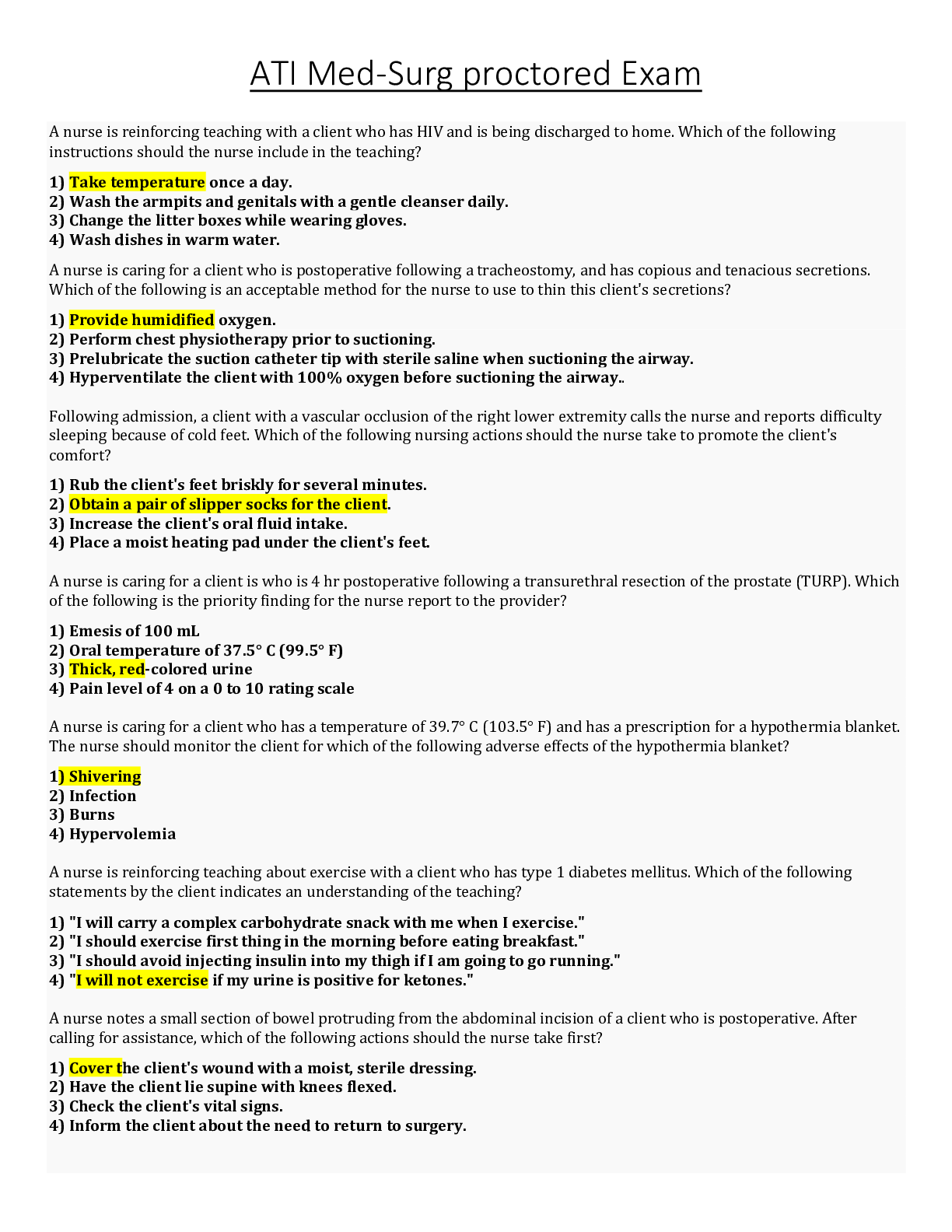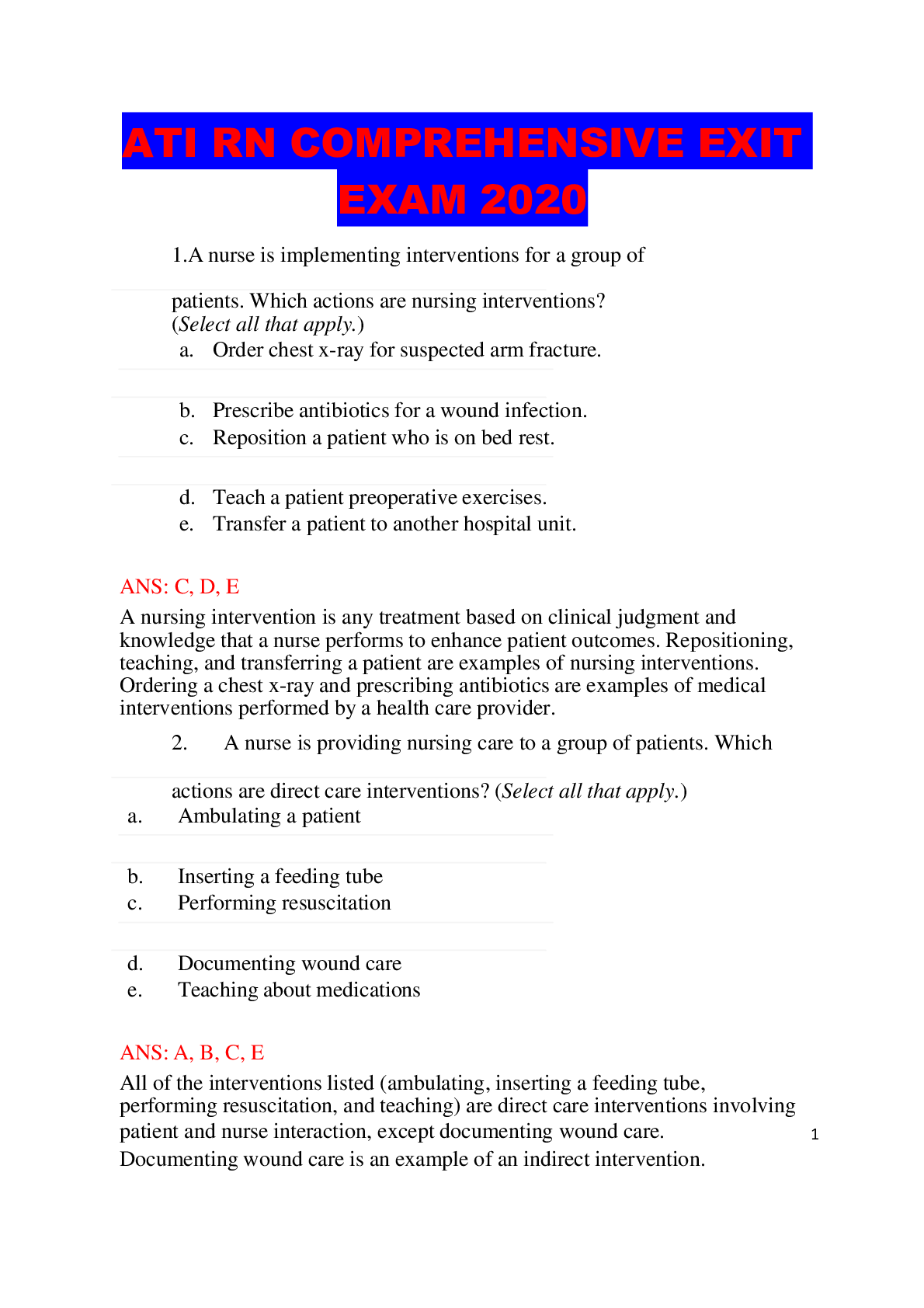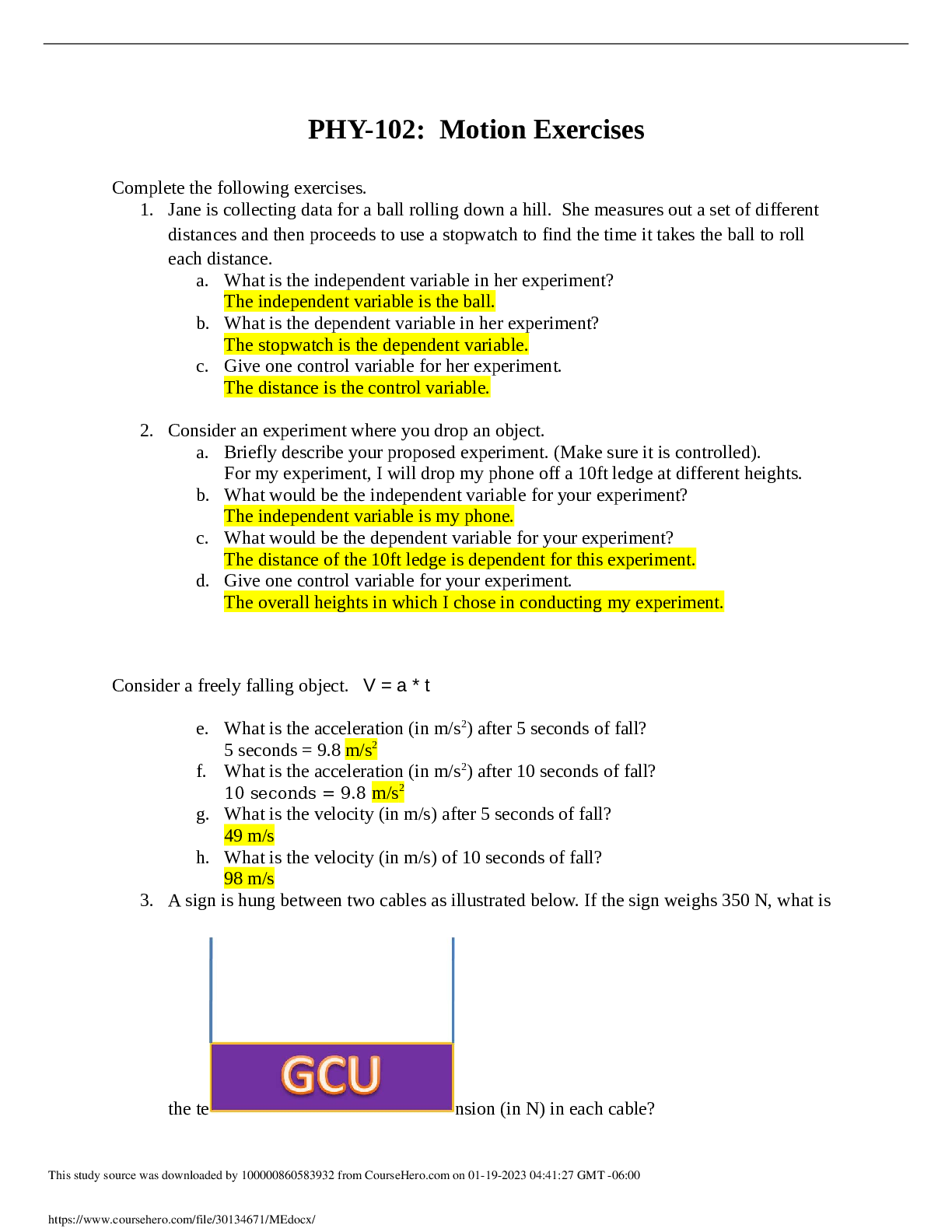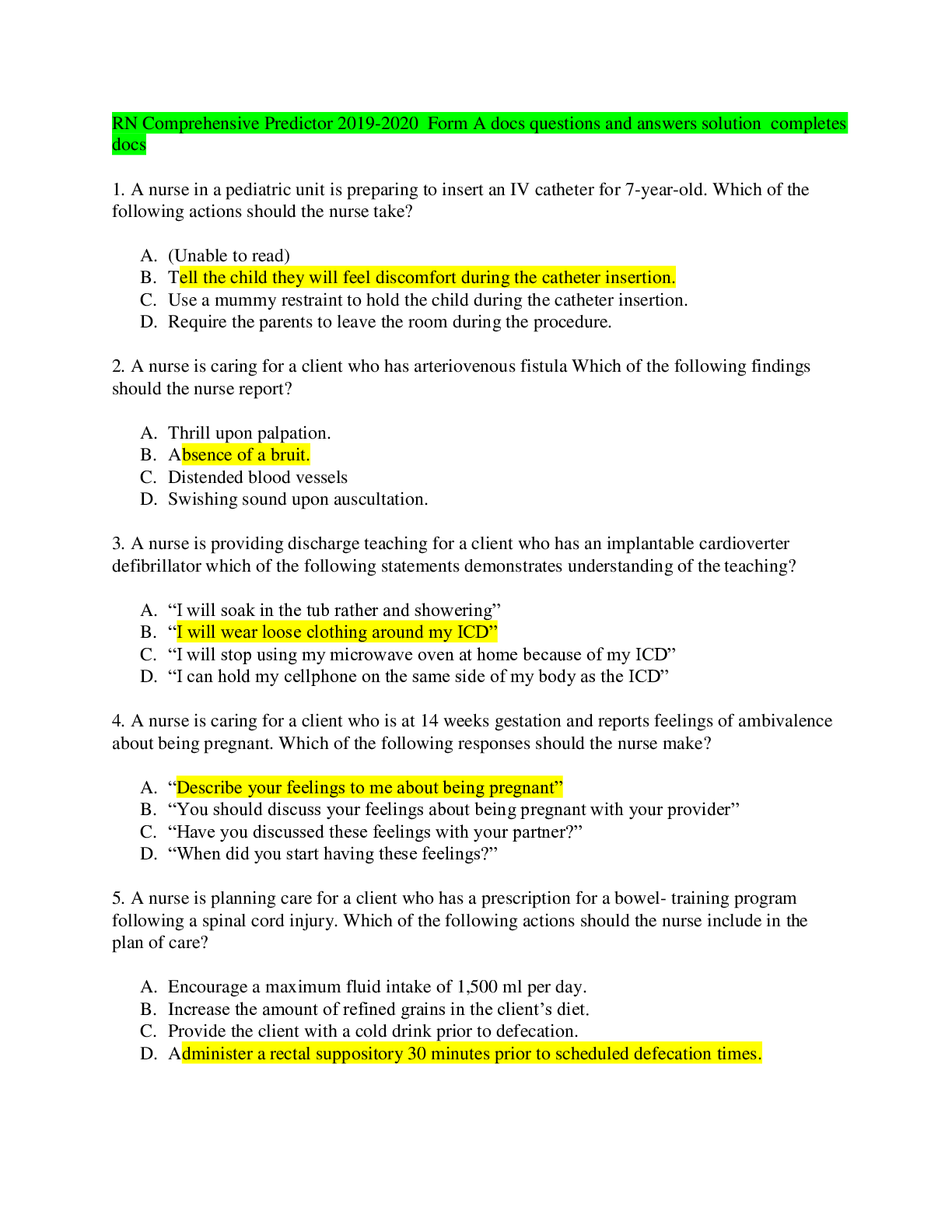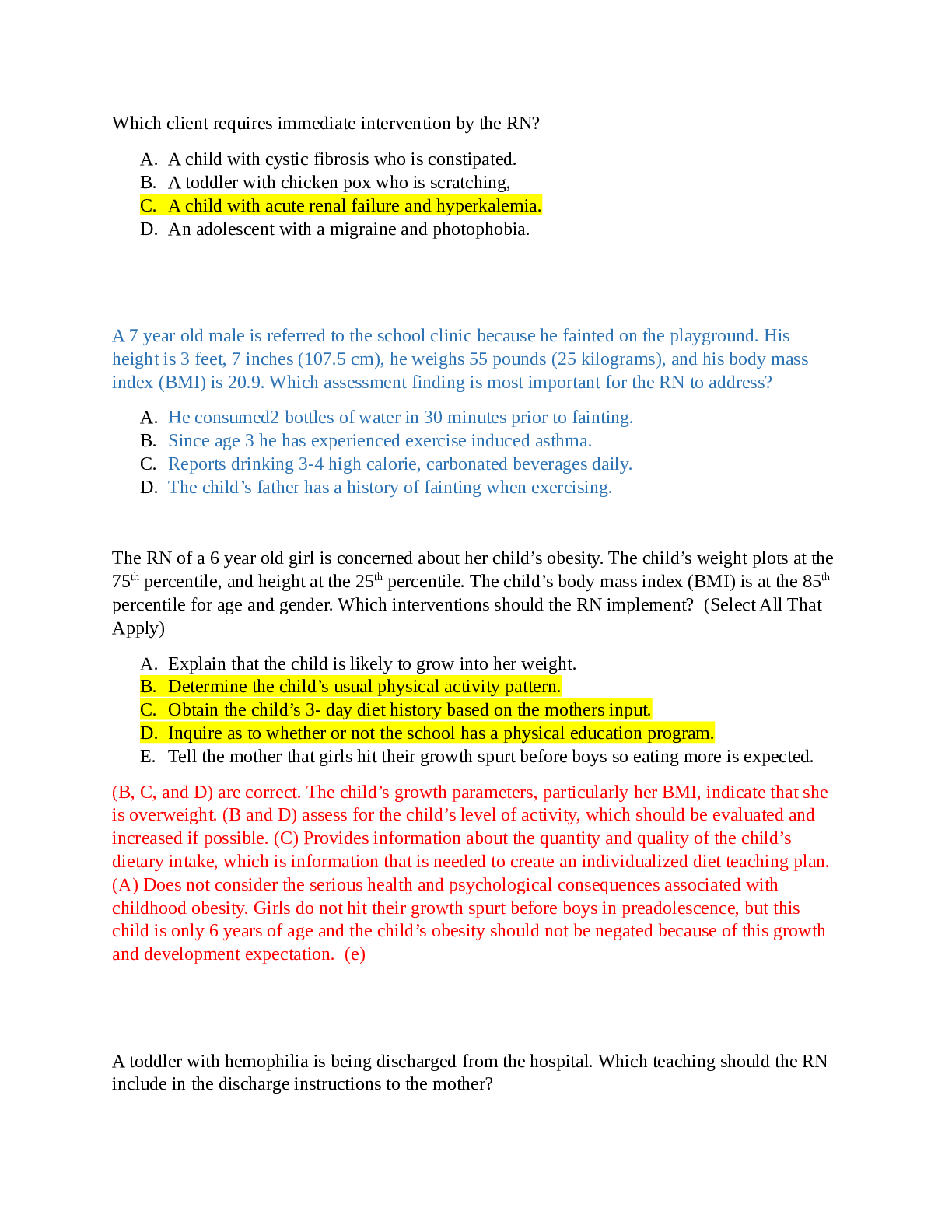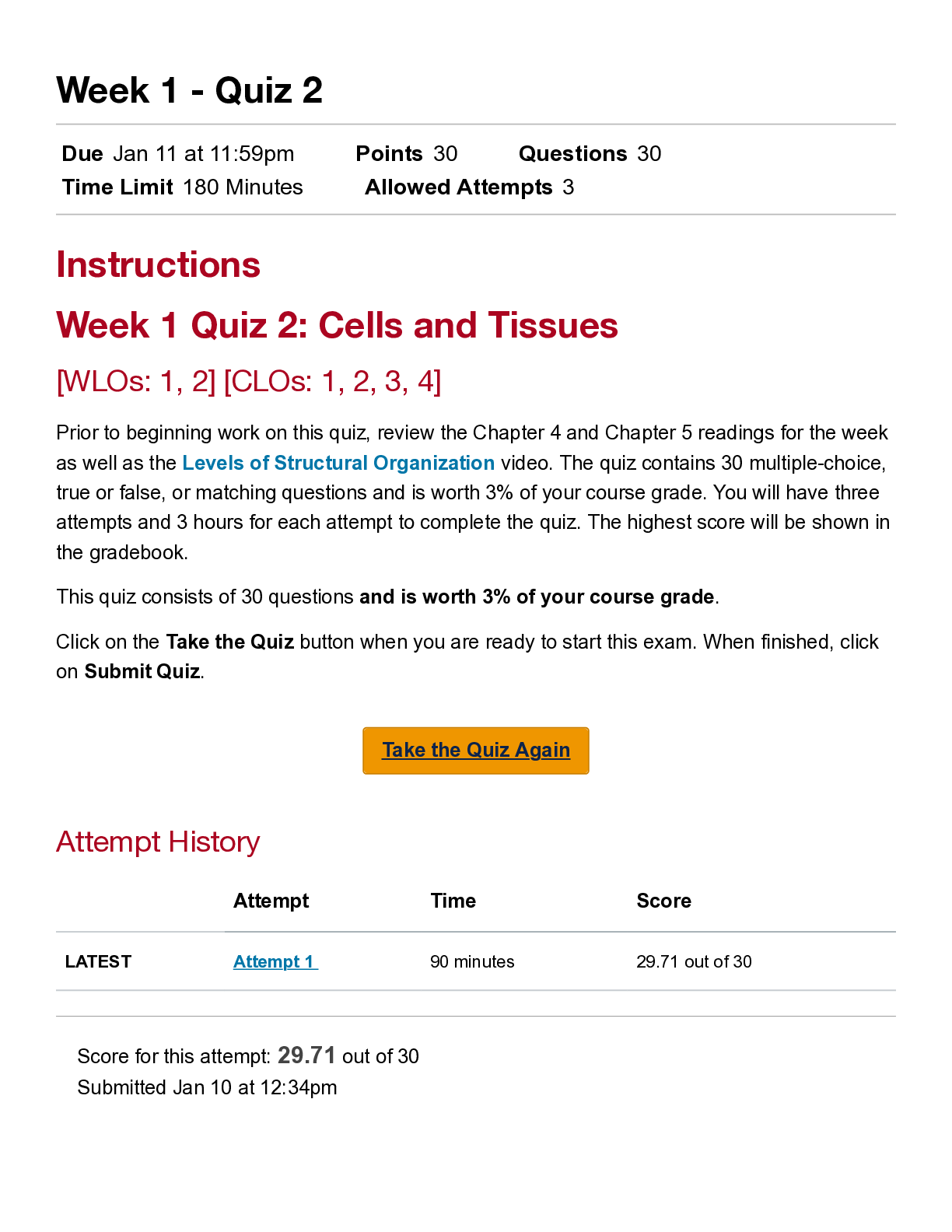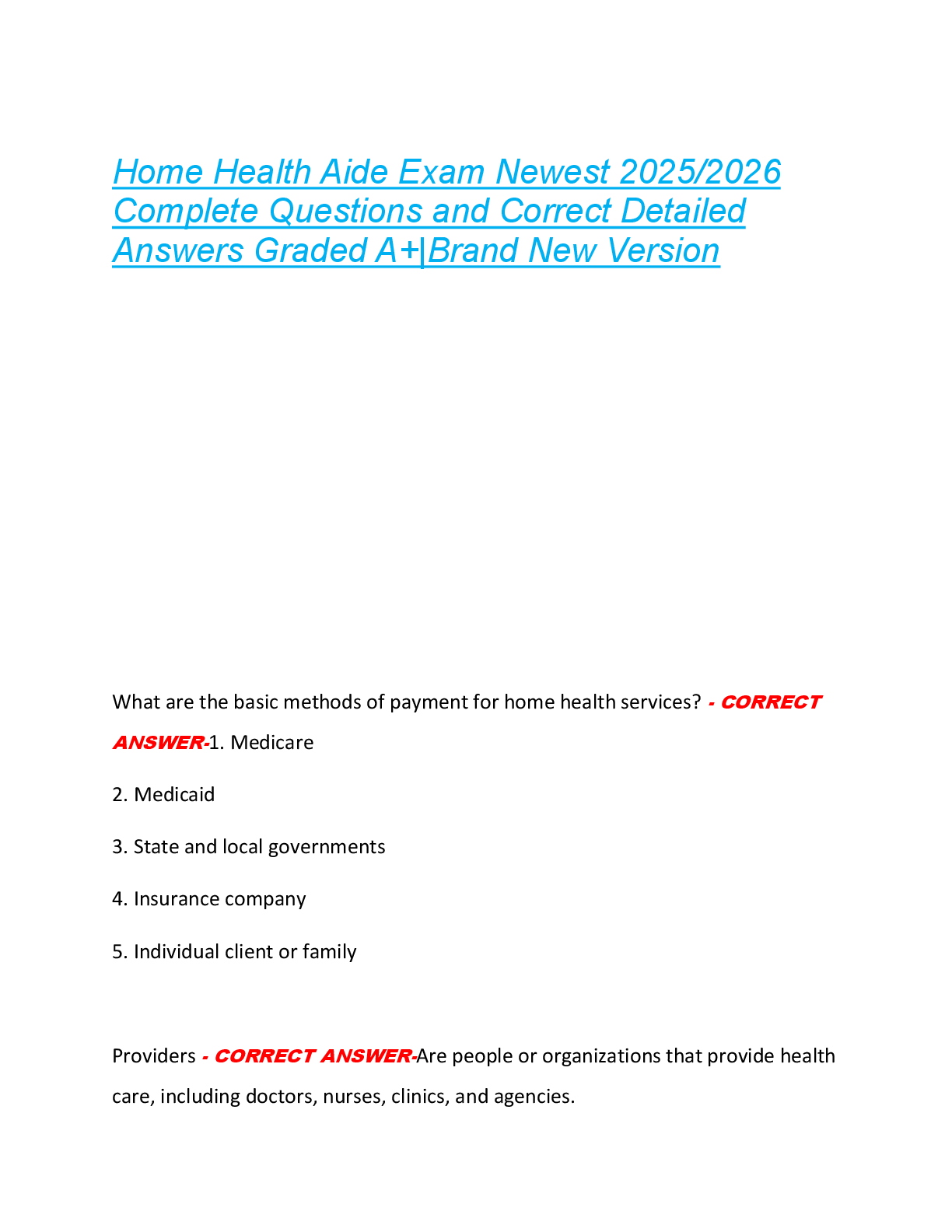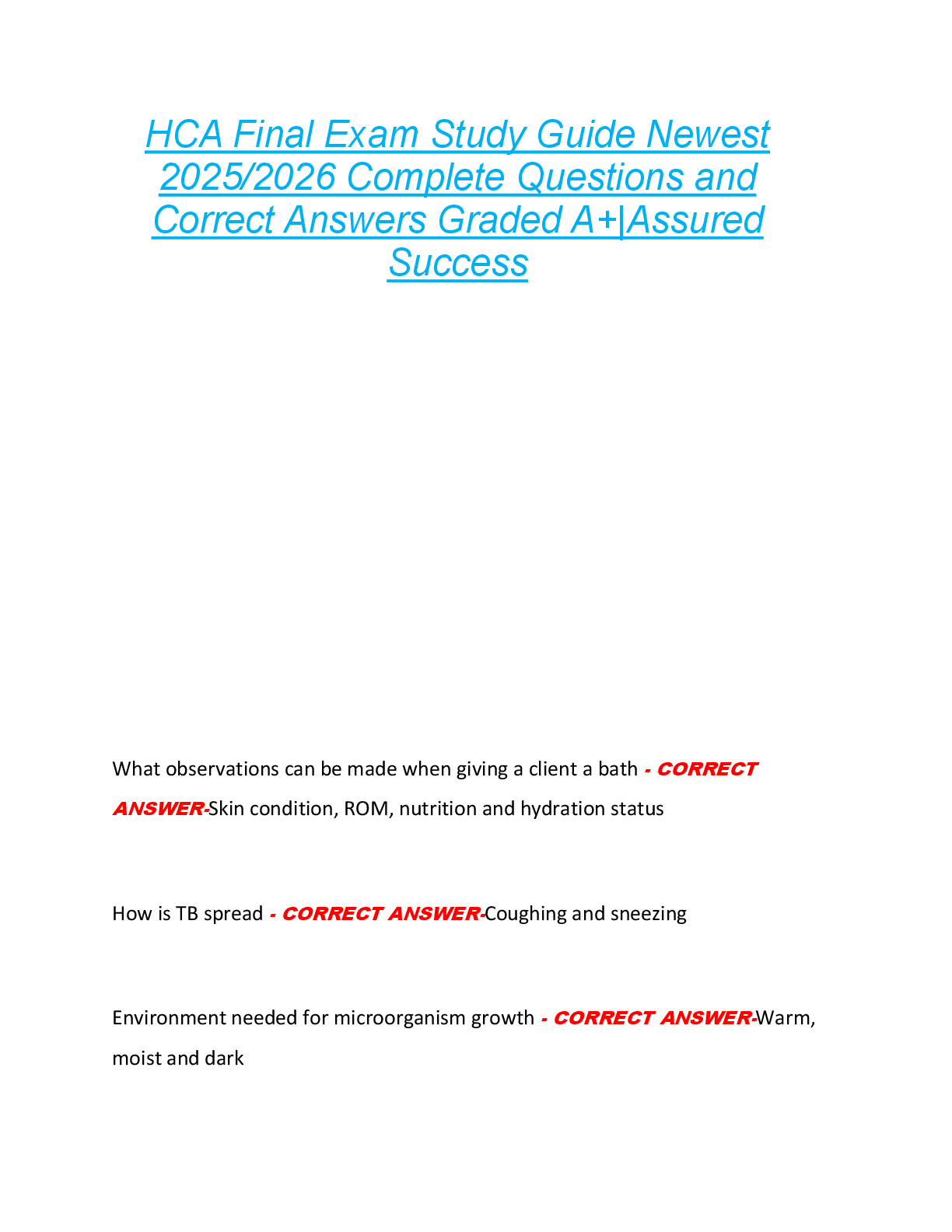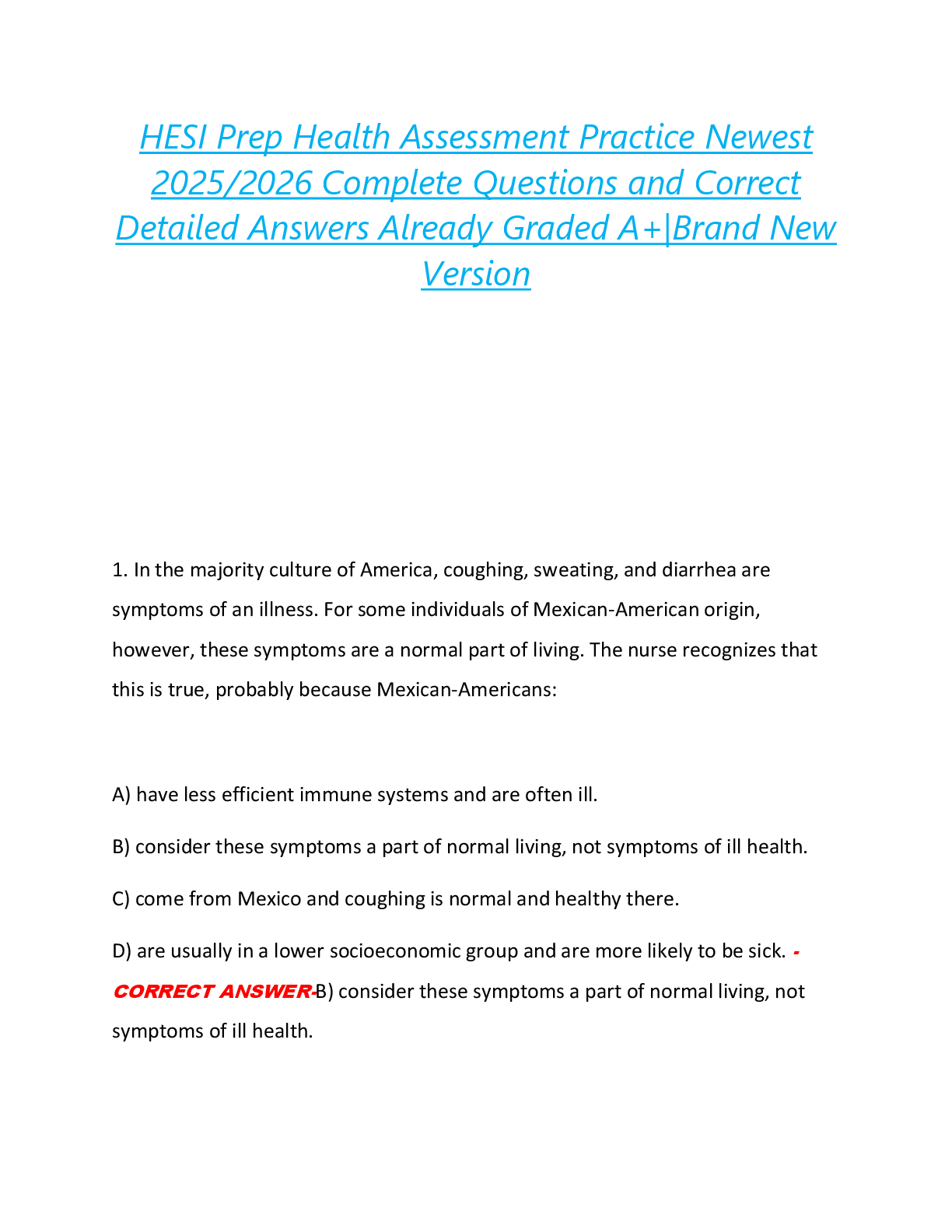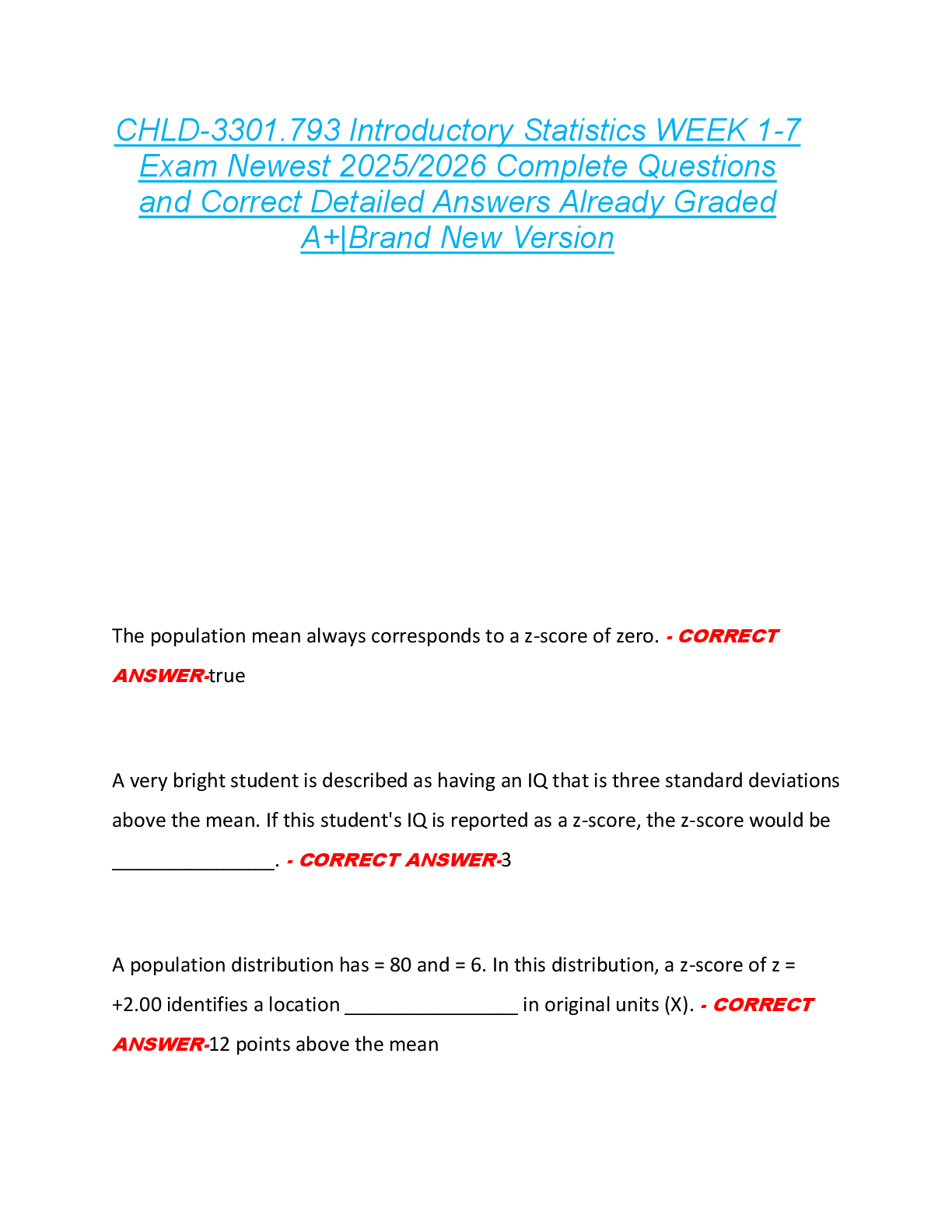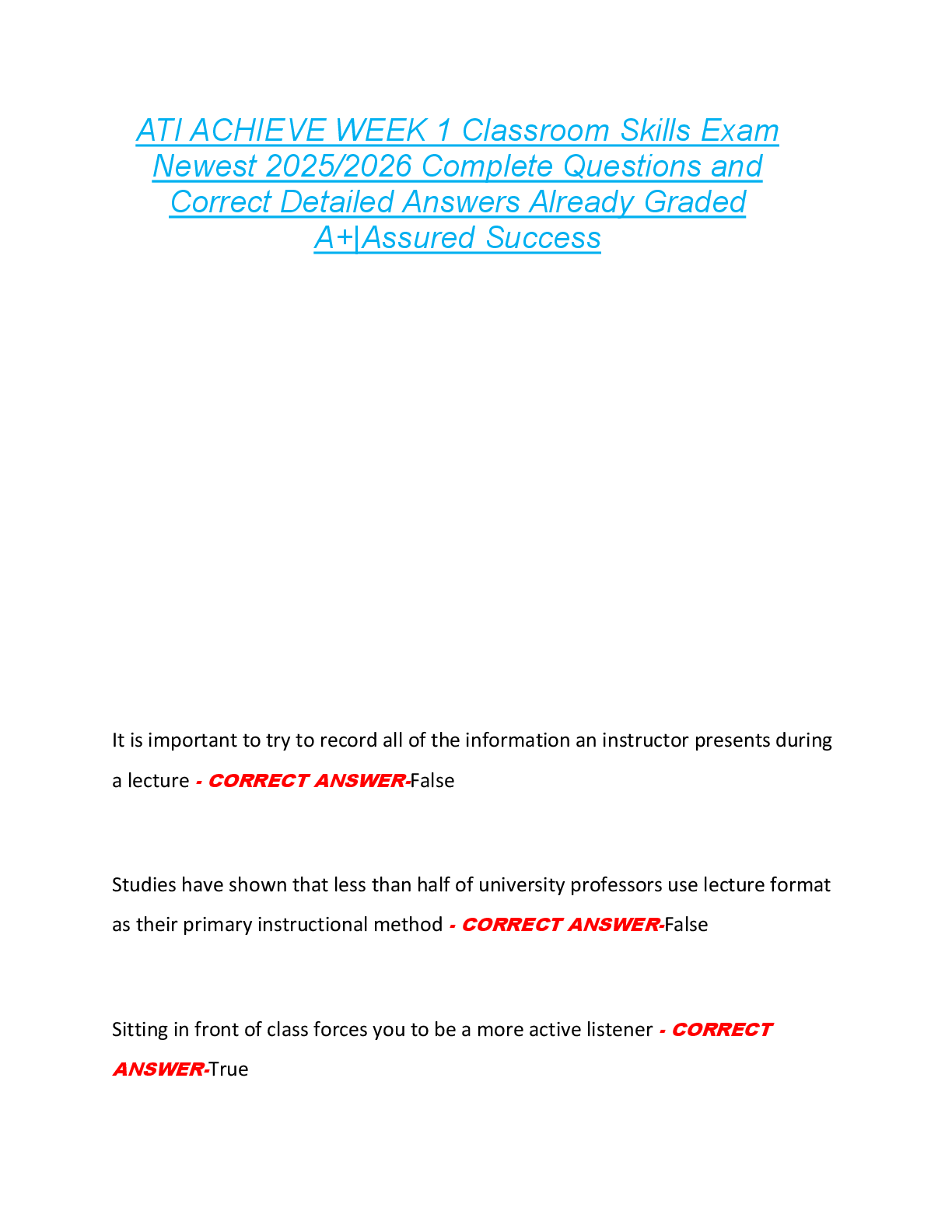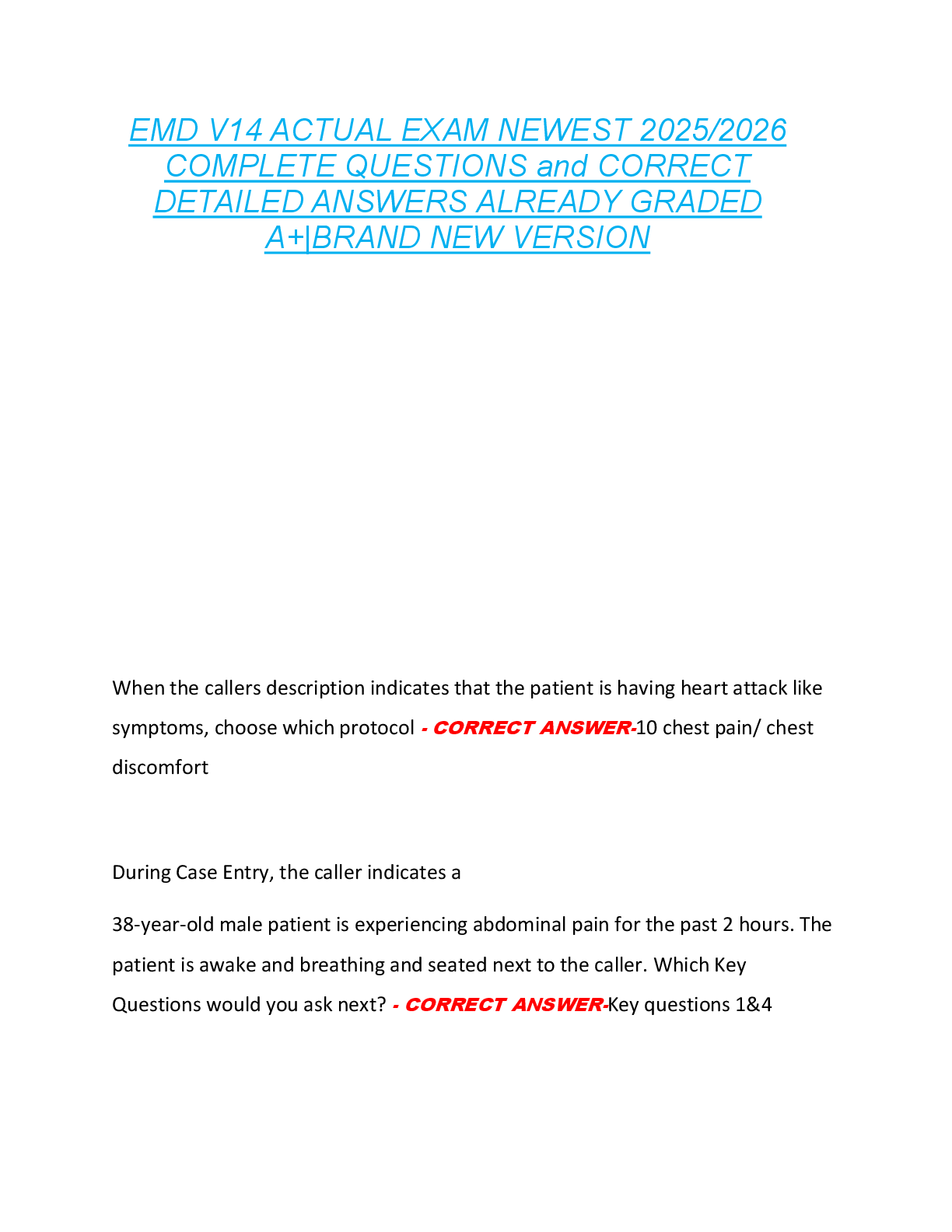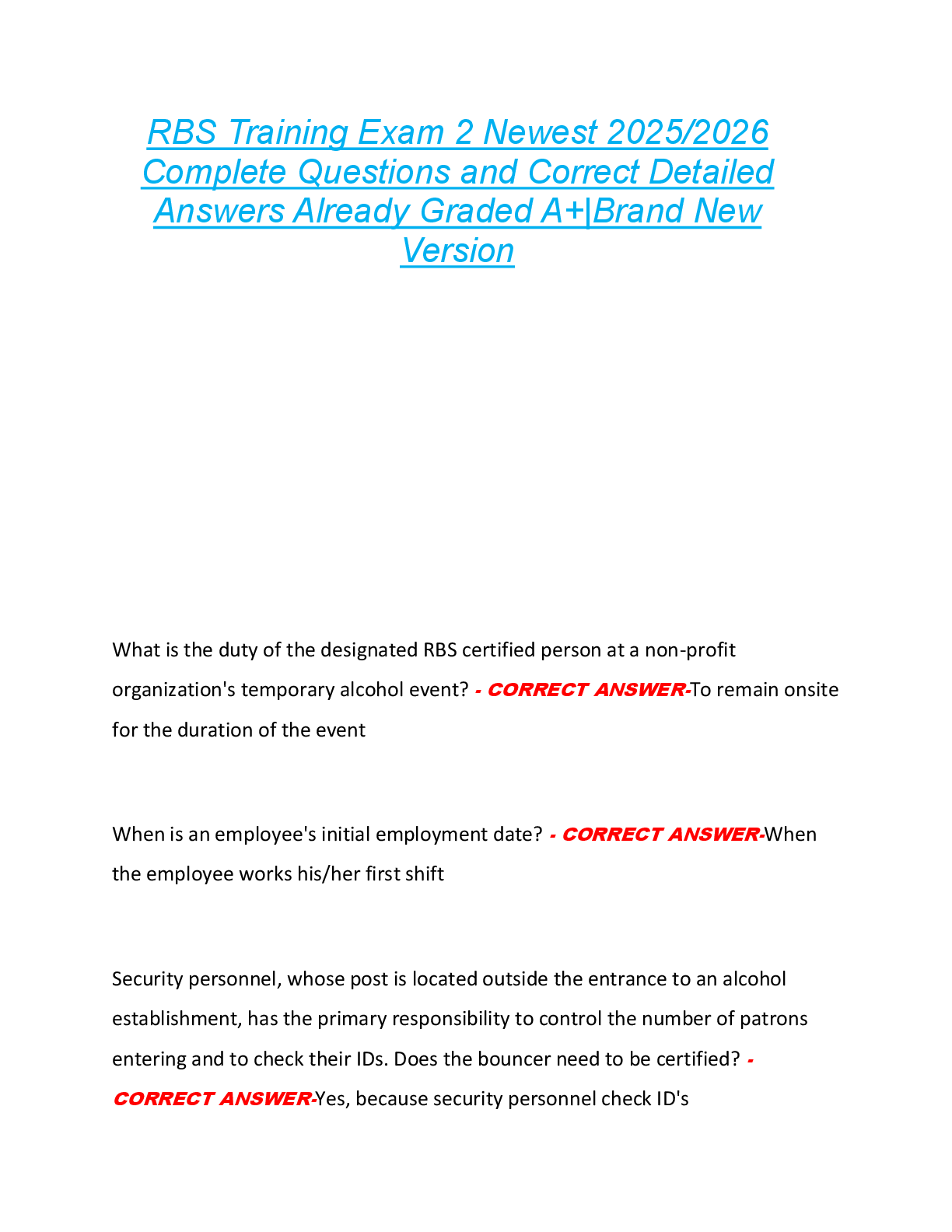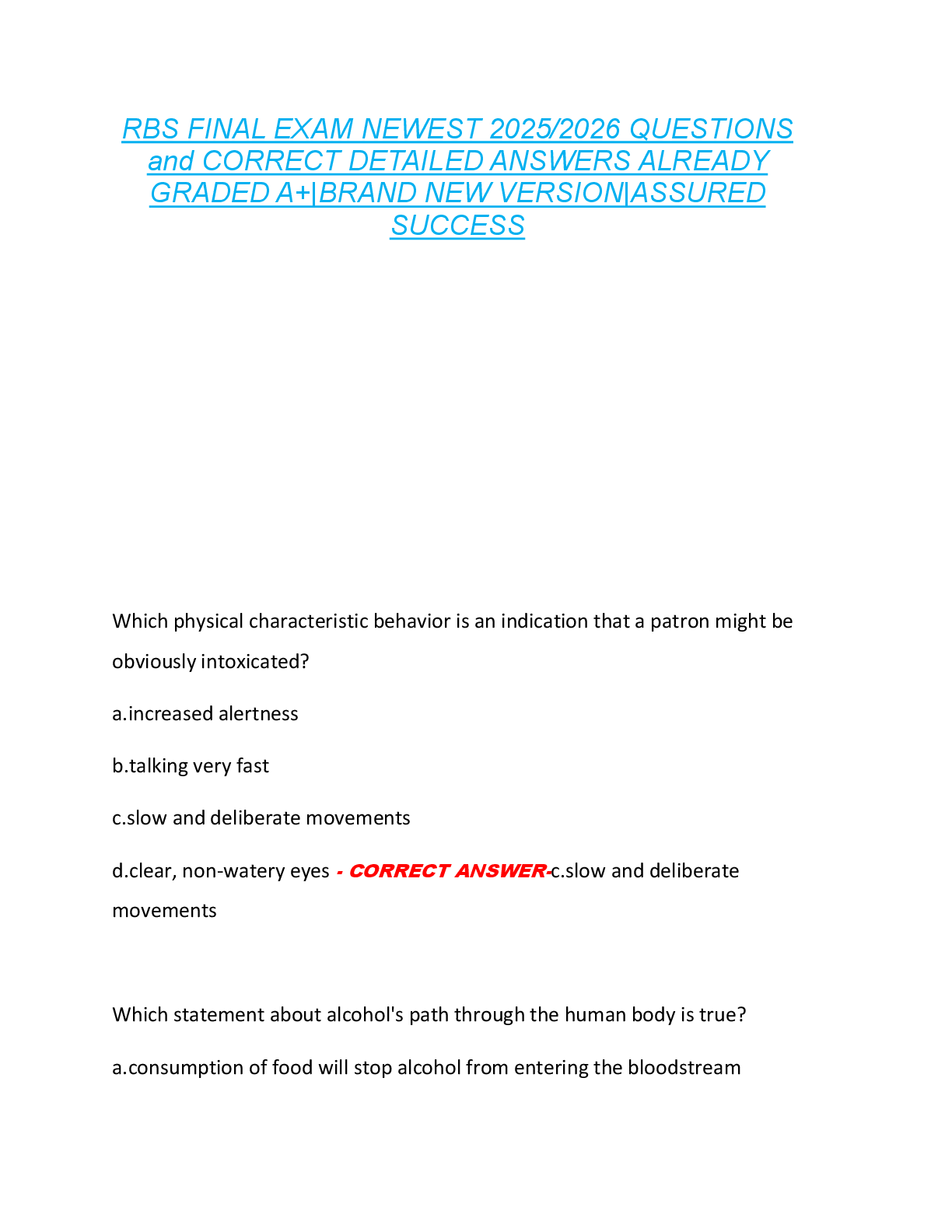*NURSING > EXAM > Kaplan University - MN 552 Unit 10 Final Exam (Questions With Correct Answers- 100% Score) (All)
Kaplan University - MN 552 Unit 10 Final Exam (Questions With Correct Answers- 100% Score)
Document Content and Description Below
Kaplan University - MN 552 Unit 10 Final Exam (Questions With Correct Answers- 100% Score MN 552 - Exam In what year did was the Durham-Humphrey Amendment enacted which stated that a physician must p ... rescribe drugs and a pharmacist must dispense them? Question options: 1932 1938 1952 1958 All of the following are schedule II medications except? Question options: Ecstasy Meperidine Cocaine Pentobarbital Which pregnancy category do medications fall under if animal studies have shown an adverse effect on the fetus, no adequate human studies, and that benefits may outweigh risks? Question options: Cat. X Cat. A Cat. B Cat. C True or False: To be found negligent and responsible for harm resulting from your professional activities, courts generally require the presence of 4 conditions, to include duty, derelict, directly and damage? Question options: True False True or False: Pharmacodynamics is the study of the body's impact on the drug to include absorption, distribution, metabolism and excretion? Question options: True False All of the following are variables that affect drug actions except? Question options: Height Weight Age Placebo response Which medication route has a 100% bioavailability? Question options: PO IM IV SQ What must be present before a drug exerts its pharmacologic action on body cells? Question options: A specified amount of time since administration The minimum effective concentration Metabolism has been completed The medication has been excreted by the kidneys True or False: Pharmacodynamics involves drug actions on target cells and the resulting alterations in cellular biochemical reactions? Question options: True False True or False: In older adults increased total body water and lean body mass-fat soluble meds stay with the patient longer? Question options: True False True or False: Zollinger-Ellison Syndrome is the excessive secretion of gastric acid and a high incidence of ulcers. It is caused by gastrin-secreting tumors in pancreas, stomach or duodenum? Question options: True False All of the following may cause Gastroesophageal Reflux Disease except? Question options: Alcohol Chocolate Beta adrenergic blockers Anticonvulsants True or False: The treatment for Helicobacter Pylori requires a combination of two antimicrobials and a PPI or an H2RA? Question options: True False All of the following are antiemetic herbal remedies except? Question options: Peppermint Saw palmetto Cayenne Meadowsweet All of the following are causes of diarrhea except: Question options: Laxative abuse Inflammatory bowel disease Gastroesophageal reflux disease Drug therapy Question options: Patients with kidney stones Pregnant patients Patients with heartburn Postmenopausal women Kelly has diarrhea and is wondering if she can take loperamide (Imodium) for the diarrhea. Loperamide: Question options: Can be given to patients of all ages, including infants and children, for viral gastroenteritis Slows gastric motility and reduces fluid and electrolyte loss from diarrhea Is the treatment of choice for the diarrhea associated with E. coli 0157 May be used in pregnancy and by lactating women Josie is a 5-year-old patient who presents to the clinic with a 48-hour history of nausea, vomiting, and some diarrhea. She is unable to keep fluids down and her weight is 4 pounds less than her last recorded weight. Besides IV fluids, her exam warrants the use of an antinausea medication. Which of the following would be the appropriate drug to order for Josie? Question options: His parents have limited finances and request the least expensive-treatment. Which medication would be the best choice for treatment? Question options: Mupirocin (Bactroban) Bacitracin and polymixin B (generic double antibiotic ointment) Retapamulin (Altabax) Oral cephalexin (Keflex) Juakeem is a nasal methicillin resistant staphylococcus aureus (MRSA) carrier. Treatment to eradicate nasal MRSA is mupirocin. Patient education regarding treating nasal MRSA includes: Question options: Take the oral medication exactly as prescribed. Insert one-half of the dose in each nostril twice a day. Alternate treating one nare in the morning and the other in the evening. Nasal MRSA eradication requires at least 4 weeks of therapy, with up to 8 weeks needed in some patients. When Sam used clotrimazole (Lotrimin AF) for athlete's foot he developed a red, itchy rash consistent with a hypersensitivity reaction. He now has athlete's foot again. What would be a good choice of antifungal for Sam? Question options: Miconazole (Micatin) powder Ketoconazole (Nizoral) cream Terbinafine (Lamisil) cream Griseofulvin (Grifulvin V) suspension Long-term treatment of moderate atopic dermatitis includes: Question options: Topical corticosteroids and emollients Topical corticosteroids alone Topical antipruritics Oral corticosteroids for exacerb of atopic dermatitis Josie has severe cystic acne and is requesting treatment with Accutane. The appropriate treatment for her would be: Question options: Order a pregnancy test and if it is negative prescribe the isotretinoin (Accutane). Order Accutane after educating her on the adverse effects. Recommend she try oral antibiotics (minocycline). Refer her to a dermatologist for treatment. Appropriate initial treatment for psoriasis would be: Question options: An immunomodulator (Protopic or Elidel) Wet soaks with Burrow's or Domeboro solution Intermittent therapy with intermediate potency topical corticosteroids Anthralin (Drithocreme) Twenty-year-old Annie comes to the clinic complaining of copious yellow -green eye discharge. Gram stain indicates she most likely has gonococcal conjunctivitis. While awaiting the culture results, the plan of care should be: Question options: None, wait for the culture results to determine the course of treatment Ciprofloxacin (Ciloxan) ophthalmic drops IM ceftriaxone High-dose oral amoxicillin Sadie was prescribed betaxolol ophthalmic drops by her ophthalmologist to treat her glaucoma. Oral beta blockers should be avoided in patients who use ophthalmic beta blockers because: Question options: There may be an antagonistic reaction between the two. The additive effects may include bradycardia. They may potentiate each other and cause respiratory depression. The additive effects may cause metabolic acidosis. David presents to the clinic with symptoms of allergic conjunctivitis. He is prescribed cromolyn sodium (Opticrom) eye drops. The education regarding using cromolyn eye drops includes: Question options: He should not wear his soft contacts while using the cromolyn eye drops. Cromolyn drops are instilled once a day to prevent allergy symptoms. Long-term use may cause glaucoma. He may experience bradycardia as an adverse effect. Jim presents with complaints of “heartburn” that is minimally relieved with Tums (calcium carbonate) and is diagnosed with gastroesophageal reflux disease (GERD). An appropriate first-step therapy would be: Question options: Omeprazole (Prilosec) twice a day Ranitidine (Zantac) twice a day Famotidine (Pepcid) once a day Metoclopramide (Reglan) four times a day An elderly person has been prescribed lactulose for treatment or chronic constipation. Monitoring with long-term treatment would include: Question options: Electrolytes, including potassium and chloride Bone mineral density for osteoporosis Magnesium level Liver function The next step in treatment when a patient has been on proton pump inhibitors twice daily for 12 weeks and not improving is : Question options: Add a prokinetic (metoclopramide) Referral for endoscopy Switch to another proton pump inhibitor Add a cytoprotective drug If a patient with H. pylori-positive peptic ulcer disease fails first-line therapy, the second-line treatment is: Question options: Proton pump inhibitor bid plus metronidazole plus tetracycline plus bismuth subsalicylate for 14 days Test H. pylori for resistance to common treatment regimens Proton pump inhibitor plus clarithromycin plus amoxicillin for 14 days Proton pump inhibitor and levofloxacin for 14 days Erika has been prescribed isotretinoin (Accutane) by her dermatologist and is presenting to her primary care provider with symptoms of sadness and depression. A Beck's Depression Scale indicates she has mild to moderate depression. What would be the best care for her at this point? Question options: Prescribe a select serotonin reuptake inhibitor (SSRI) antidepressant Refer her to a mental health therapist Contact her dermatologist about discontinuing the isotretinoin Reassure her that mood swings are normal and schedule follow up in a week Jesse is prescribed tazarotene for his psoriasis. Patient education regarding topical tazarotene includes instructing them: Question options: That tazarotene is applied in a thin film to the psoriasis plaque lesions To apply it liberally to all psoriatic lesions To apply tazarotene to nonaffected areas to prevent breakout That tazarotene may cause hypercalcemia if it is overused Nicolas is a football player who presents to the clinic with athlete's foot. Patients with tinea pedis may be treated with: Question options: OTC miconazole cream for 4 weeks Oral ketoconazole for 6 weeks Mupirocin ointment for 2 weeks Nystatin cream for 2 weeks Vanessa has been diagnosed with scabies. Her education would include: Question options: She should apply the scabies treatment cream for an hour and wash it off. Scabies may need to be retreated in a week after initial treatment. All members of the household and close personal contacts should be treated. Malathion is flammable and she should take care until the solution dries. Ciprofloxacin otic drops are contraindicated in: Question options: Children Patients with acute otitis externa Patients with a perforated tympanic membrane Swimmer's ear Janie presents to the clinic with hard ear wax in both ear canals. Instructions regarding home removal of hard cerumen include: Question options: Moisten a cotton swab (Q-tip) and swab the ear canal twice daily. Instill tap water in both ears while bathing. Squirt hydrogen peroxide into ears with each bath. Instill carbamide peroxide (Debrox) twice daily until canals are clear. Digoxin levels need to be monitored closely when the following medication is started: Question options: Loratadine Diphenhydramine Ipratropium Albuterol When educating patients who are starting on inhaled corticosteroids, the provider should tell them that: Question options: They need to get any live vaccines before starting the medication. Inhaled corticosteroids need to be used daily during asthma exacerbations to be effective. Patients should rinse their mouths out after using the inhaled corticosteroid to prevent thrush. They can triple the dose number of inhalations of medication during colds to prevent needing systemic steroids. Second-generation antihistamines such as loratadine (Claritin) are prescribed for seasonal allergies because they are: Question options: More effective than first-generation antihistamines Less sedating than the first-generation antihistamines Prescription products, therefore are covered by insurance Able to be taken with central nervous system (CNS) sedatives, such as alcohol Henry presents to clinic with a significantly swollen, painful great toe and is diagnosed with gout. Of the following, which would be the best treatment for Henry? Question options: High-dose colchicine Low-dose colchicine High-dose aspirin Acetaminophen with codeine Patients whose total dose of prednisone will exceed 1 gram will most likely need a second prescription for: Question options: Metformin, a biguanide to prevent diabetes Omeprazole, a proton pump inhibitor to prevent peptic ulcer disease Naproxen, an NSAID to treat joint pain Furosemide, a diuretic to treat fluid retention Patients prescribed aspirin therapy require education regarding the signs of aspirin toxicity. An early sign of aspirin toxicity is: Question options: Black tarry stools Vomiting Tremors Tinnitus Prior to developing a plan for the treatment of asthma, the patient's asthma should be classified according to the NHLBI Expert Panel 3 guidelines. In adults mild-persistent asthma is classified as asthma symptoms that occur: Question options: Haemophilusinfluenzae Staphylococcus aureus Mycoplasma pneumoniae Streptococcus pneumonia The first-line antibiotic choice for a patient with comorbidities or who is immunosuppressed who has pneumonia and can be treated as an outpatient would be: Question options: Levofloxacin Amoxicillin Ciprofloxacin is a 4-year Wing-ax-year-Cephale -old patient who has suspected bacterial pneumonia. He has a temperature of 102 ° F, oxygen saturation level of 95%, and is taking fluids adequately. What would be appropriate initial treatment for his pneumonia? Question options: Ceftriaxone Azithromycin Cephalexin Levofloxacin Instructions for a patient who is starting nicotine replacement therapy include: Question options: Smoke less than 10 cigarettes a day when starting nicotine replacement. Nicotine replacement will help with the withdrawal cravings associated with quitting tobacco. Nicotine replacement can be used indefinitely. Nicotine replacement therapy is generally safe for all patients. If prescribing bupropion (Zyban) for tobacco cessation, the instructions to the patient include: Question options: Bupropion (Zyban) is started 1 to 2 weeks before the quit date. Nicotine replacement products should not be used with bupropion. If they smoke when taking bupropion they may have increased anxiety and insomnia. Because they are not using bupropion as an antidepressant, they do not need to worry about increased The most appropriate smoking cessation prescription for pregnant women is: Question options: A nicotine replacement patch at the lowest dose available Bupropion (Zyban) incorrect Varenicline (Chantix) Nonpharmacologic measurescorrect Drug resistant tuberculosis (TB) is defined as TB that is resistant to: Question options: Fluoroquinolones Rifampin and isoniazid Amoxicillin Ceftriaxone Kaleb has extensively resistant tuberculosis ( TB). Treatment for extensively resistant TB would include: Question options: INH, rifampin, pyrazinamide, and ethambutol for at least 12 months INH, ethambutol, kanamycin, and rifampin Treatment with at least two drugs to which the TB is susceptible Levofloxacin Ezekiel is a 9- year-old patient who lives in a household with a family member newly diagnosed with tuberculosis (TB). To prevent Ezekiel from developing TB he should be treated with: Question options: 6 months of Isoniazid (INH) and rifampin 2 months of INH, rifampin, pyrazinamide, and ethambutol, followed by 4 months of INH 9 months of INH 12 months of INH Myles is a 2-year-old patient who has been diagnosed with acute otitis media. He is afebrile and has not been treated with antibiotics recently. First-line treatment for his otitis media would include: Question options: Azithromycin Amoxicillin Ceftriaxone Trimethoprim / sulfamethoxazole Jacob has been diagnosed with sinusitis. He is the parent of a child in daycare. Treatment for sinusitis in an adult who has a child in daycare is: Question options: Azithromycin 500 mg q day for 5 days Amoxicillin-clavulanate 500 mg bid for 7 days Ciprofloxacin 500 mg bid for 5 days Cephalexin 500 mg qid for 5 days Elderly patients who are started on levothyroxine for thyroid replacement should be monitored for: Question options: Excessive sedation Tachycardia and angina Weight gain Cold intolerance Potentially fatal granulocytopenia has been associated with treatment of hyperthyroidism with propylthiouracil. Patients should be taught to report: Question options: Tinnitus and decreased salivation Fever and sore throat Hypocalcemia and osteoporosis Laryngeal edema and difficulty swallowing Metformin is a primary choice of drug to treat hyperglycemia in type 2 diabetes because it: Question options: Substitutes for insulin usually secreted by the pancreas Decreases glycogenolysis by the liver Increases the release of insulin from beta cells Decreases peripheral glucose utilization Hypoglycemia can result from the action of either insulin or an oral hypoglycemic. Signs and symptoms of hypoglycemia include: Question options: “Fruity” breath odor and rapid respiration Diarrhea, abdominal pain, weight loss, and hypertension Dizziness, confusion, diaphoresis, and tachycardia Easy bruising, palpitations, cardiac dysrhythmias, and coma Sulfonylureas may be added to a treatment regimen for type 2 diabetics when lifestyle modifications and metformin are insufficient to achieve target glucose levels. Sulfonylureas have been moved to Step 2 therapy because they: Question options: Increase endogenous insulin secretion Have a significant risk for hypoglycemia Address the insulin resistance found in type 2 diabetics Improve insulin binding to receptors Treatment with insulin for type 1 diabetics: Question options: Starts with a total daily dose of 0.2 to 0.4 units per kg of body weight Divides the total doses into three injections based on meal size Uses a total daily dose of insulin glargine given once daily with no other insulin required Is based on the level of blood glucose The American Heart Association states that people with diabetes have a 2- to 4-fold increase in the risk of dying from cardiovascular disease. Treatments and targets that do not appear to decrease risk for micro- and macro-vascular complications include: Question options: Glycemic targets between 7% and 7. Washing their hands after applying the gel Wearing occlusive clothing while using the gel Exposure to estrogens while using the gel Skin-to-skin contact with pregnant women while using the gel A 22-year-old woman receives a prescription for oral contraceptives. Education for this patient includes: Question options: Counseling regarding decreasing or not smoking while taking oral contraceptives Advising a monthly pregnancy test for the first 3 months she is taking the contraceptive Advising that she may miss two pills in a row and not be concerned about pregnancy Recommending that her next follow-up visit is in 1 year for a refill and annual exam A 56-year-old woman is complaining of vaginal dryness and dyspareunia. To treat her symptoms with the lowest adverse effects she should be prescribed: Question options: Low-dose oral estrogen A low-dose estrogen / progesterone combination A vaginal estradiol ring Vaginal progesterone cream Ashley comes to the clinic with a request for oral contraceptives. She has successfully used oral contraceptives before and has recently started dating a new boyfriend so would like to restart contraception. She denies recent intercourse and has a negative urine pregnancy test in the clinic. An appropriate plan of care would be: Question options: Recommend she return to the clinic at the start of her next menses to get a Depo Provera shot. Prescribe oral combined contraceptives and recommend she start them at the beginning of her next period Prescribe oral contraceptives and have her start them the same day as the visit with a back-up method Discuss the advantages of using the topical birth control patch and recommend she consider using the Women who are prescribed progestin-only contraception need education regarding which common adverse drug effects? Question options: Increased migraine headaches Increased risk of developing blood clots Irregular vaginal bleeding for the first few months Increased risk for hypercalcemia Oral emergency contraception (Plan B) is contraindicated in women who: Question options: Had intercourse within the past 72 hours May be pregnant Are taking combined oral contraceptives Are using a diaphragm When blood glucose levels are difficult to control in type 2 diabetes some form of insulin may be added to the treatment regimen to control blood glucose and limit complication risks . Which of the following statements is accurate based on research? Question options: Premixed insulin analogues are better at lowering HbA1C and have less risk for hypoglycemia. Premixed insulin analogues and the newer premixed insulins are associated with more weight gain than Newer premixed insulins are better at lowering HbA1C and postprandial glucose levels than long-acting Patients who are not controlled on oral agents and have postprandial hyperglycemia can have neutral to prescribing metformin , the provider should: Question options: Draw a serum creatinine to assess renal function Try the patient on insulin Tell the patient to increase iodine intake Have the patient stop taking any sulfonylurea to avoid dangerous drug interactions Insulin preparations are divided into categories based on onset, duration, and intensity of action following subcutaneous injection. Which of the following insulin preparations has the shortest onset and duration of action? Question options: Levemir Glulisine Glargine Detemir The drugs recommended for older adults with type 2 diabetes include: Question options: Second-generation sulfonylureas Metformin Pioglitazone Third-generation sulfonylureas Women with an intact uterus should be treated with both estrogen and progestin due to: Question options : and thyroid level Patients taking hormonal contraceptives and hormone replacement therapy need to take the drug daily at the same time to prevent: Question options: Nausea Breakthrough bleeding Breast tenderness Pregnancy The mechanism of action of oral combined contraceptives that prevents pregnancy is: Question options: Estrogen prevents the luteinizing hormone surge necessary for ovulation. Progestins thicken cervical mucus and slow tubal motility. Estrogen thins the endometrium making implantation difficult. Progestin suppresses follicle stimulating hormone release. When starting a patient with hypothyroidism on thyroid replacement hormones patient education would include: Question options: They should feel symptomatic improvement in 1 to 2 weeks. Drug adverse effects such as lethargy and dry skin may occur. It may take 4 to 8 weeks to get to euthyroid symptomatically and by laboratory testing. Because of its short half-life, levothyroxine doses should not be missed. Jonathan has been diagnosed with strep throat and needs a prescription for an antibiotic. He says the last time he had penicillin he developed a red, blotchy rash. An appropriate antibiotic to prescribe would be: Question options: Penicillin VK, because his rash does not sound like a serious rash Amoxicillin Cefadroxil (Duricef) Azithromycin Nicholas has been diagnosed with type A influenza. Appropriate prescribing of oseltamivir (Tamiflu) would include: Question options: Starting oseltamivir within the first 48 hours of influenza symptoms Advising the patient he can stop the oseltamivir when his symptoms resolve Educating the patient that oseltamivir will cure influenza Prophylactic treatment of all family members The drug of choice for treatment of primary or secondary syphilis is: Question options: Ceftriaxone IM Benzathine penicillin G IM Oral azithromycin Oral ciprofloxacin When treating suspected gonorrhea in a nonpregnant patient, the patient should be concurrently treated for chlamydia with: Question options: Azithromycin 1 gram PO x 1 Amoxicillin 500 mg PO x 1 Ciprofloxacin 500 mg PO x 1 Penicillin G 2.4 million units IM x 1 Lila is 24 weeks pregnant and has been diagnosed with tuberculosis (TB). Treatment regimens for a pregnant patient with TB would include: Question options: Streptomycin Levofloxacin Kanamycin Pyridoxine The principles of drug therapy for the treatment of tuberculosis include: Question options: Patients are treated with a drug to which M. tuberculosis is sensitive. Drugs need to be taken on a regular basis for a sufficient amount of time. Treatment continues until the patient's purified protein derivative is negative. All of the above Jaheem is a 10-year-old low-risk patient with sinusitis. Treatment for a child with sinusitis is: Question options: Amoxicillin Azithromycin Cephalexin Levofloxacin Alyssa is a 15-month-old patient who has been on amoxicillin for 2 days for acute otitis media. She is still febrile and there is no change in her tympanic membrane examination. What would be the plan of care for her? Question options: Continue the amoxicillin for the full 10 days. Change the antibiotic to azithromycin. Change the antibiotic to amoxicillin / clavulanate. Change the antibiotic to trimethoprim / sulfamethoxazole. Sally is a 16-year-old female with a urinary tract infection. She is healthy, afebrile, with no use of antibiotics in the previous 6 months and no drug allergies. An appropriate first-line antibiotic choice for her would be: Question options: Azithromycin Trimethoprim / sulfamethoxazole Ceftriaxone Levofloxacin Jamie is a 24-year-old female with a urinary tract infection. She is healthy, afebrile, and her only drug allergy is sulfa, which gives her a rash. An appropriate first-line antibiotic choice for her would be: Question options: Azithromycin Trimethoprim / sulfamethoxazole Ceftriaxone Ciprofloxacin Pong-tai is a 12-month-old child who is being treated with amoxicillin for acute otitis media. His parents call the clinic and say he has developed diarrhea. The appropriate action would be to: Question options: Advise the parents that some diarrhea is normal with amoxicillin and recommend probiotics daily. Change the antibiotic to one that is less of a gastrointestinal irritant. Order stool cultures for suspected viral pathogens not treated by the amoxicillin. Recommend increased fluids and fiber in his diet. To prevent further development of antibacterial resistance it is recommended that fluoroquinolones be reserved for treatment of: Question options: Urinary tract infections in young women Upper respiratory infections in adults Skin and soft tissue infections in adults Community-acquired pneumonia in patients with comorbidities Treatment for suspected gonorrhea is: Question options: Ceftriaxone 250 mg IM x 1 Ceftriaxone 2 grams IM x 1 Ciprofloxacin 500 mg PO x 1 Doxycycline 100 mg bid x 7 days If a woman presents with recurrent vulvovaginal candidiasis she may be treated with: Question options: Weekly intravaginal butoconazole for 3 months Fluconazole 150 mg PO daily x 7 doses then monthly for 6 months Weekly fluconazole 150 mg PO x 6 months Intravaginal tioconazole x 14 days Bilal is a 5-year-old patient who has been diagnosed with tuberculosis. His treatment would include: Question options: Pyridoxine Ethambutol Levofloxacin Rifabutin Isabella has confirmed tuberculosis and is placed on a 6-month treatment regimen. The 6-month regimen consists of: Question options: Two months of four-drug therapy (INH, rifampin, pyrazinamide, and ethambutol) followed by Four months Six months of INH with daily pyridoxine throughout therapy Six months of INH, rifampin, pyrazinamide, and ethambutol Any of the above First-line therapy for a patient with acute otitis externa (swimmer's ear) and an intact tympanic membrane includes: Question options: Swim-Ear drops Ciprofloxacin and hydrocortisone drops Amoxicillin Gentamicin ophthalmic drops The length of treatment for sinusitis in a low-risk patient should be: Question options: 5–7 days 7–10 days 14–21 days 7 days beyond when symptoms cease Nicole is a 4-year-old female with a febrile urinary tract infection (UTI). She is generally healthy and has no drug allergies. Appropriate initial therapy for her UTI would be: Question options: Azithromycin Trimethoprim / sulfamethoxazole Ceftriaxone Ciprofloxacin Juanita is a 28-year-old pregnant woman at 38 weeks' gestation who is diagnosed with a lower urinary tract infection (UTI). She is healthy with no drug allergies. Appropriate first-line therapy for her UTI would be: Question options: Azithromycin Trimethoprim / sulfamethoxazole Amoxicillin Ciprofloxacin Ray has been diagnosed with hypertension and an angiotensin-converting enzyme inhibitor is determined to be needed. Prior to prescribing this drug, the NP should assess for: Question options: Hypokalemia Impotence Decreased renal function Inability to concentrate Which of the following create a higher risk for digoxin toxicity? Both the cause and the reason for it must be correct. Question options: Older adults because of reduced renal function Administration of aldosterone antagonist diuretics because of decreased potassium levels Taking an antacid for gastroesophageal reflux disease because it increases the absorption of digoxin Doses between 0.25 and 0.5 mg / day Juanita had a deep vein thrombosis (DVT) and was on heparin in the hospital and was discharged on warfarin. She asks her primary care provider NP why she was getting both medications while in the hospital. The best response is to: Question options: Contact the hospitalist as this is not the normal guideline for prescribing these two medications and she Explain that warfarin is often started while a patient is still on heparin because warfarin takes a few days Encourage the patient to contact the Customer Service department at the hospital as this was most likely Draw anticoagulation studies to make sure she does not have dangerously high bleeding times. Robert, age 51 years, has been told by his primary care provider (PCP) to take an aspirin a day. Why would this be recommended? Question options: He has arthritis and this will help with the inflammation and pain. Aspirin has anti-platelet activity and prevents clots that cause heart attacks. Aspirin acidifies the urine and he needs this for prostrate health. He has a history of GI bleed, and one aspirin a day is a safe dosage. Education of patients who are taking warfarin includes discussing their diet. Instructions include: Question options: Avoiding all vitamin K-containing foods Avoiding high-vitamin K-containing foods Increasing intake of iron-containing foods Making sure they eat 35 grams of fiber daily Pernicious anemia is treated with: Question options: Folic acid supplements Thiamine supplements Vitamin B12 Iron Valerie presents to the clinic with menorrhagia. Her hemoglobin is 10.2 and her ferritin is 15 ng / mL. Initial treatment for her anemia would be: Question options: 18 mg / day of iron supplementation 6 mg / kg per day of iron supplementation 325 mg ferrous sulfate per day 325 mg ferrous sulfate tid Kyle has Crohn's disease and has a documented folate deficiency. Drug therapy for folate deficiency anemia is: Question options: Oral folic acid 1 to 2 mg per day Oral folic acid 1 gram per day IM folate weekly for at least 6 months Oral folic acid 400 mcg daily Angina is produced by an imbalance between myocardial oxygen supply (MOS) and demand (MOD) in the myocardium. Which of the following drugs help to correct this imbalance by increasing MOS? Question options: Calcium channel blockers Beta blockers Angiotensin-converting-enzyme (ACE) inhibitors Aspirin The rationale for prescribing calcium blockers for angina can be based on the need for: Question options: Increased inotropic effect in the heartwrong it decreases Increasing peripheral perfusion Keeping heart rates high enough to ensure perfusion of coronary arteries Help with rate control correct Which of the following drugs has been associated with increased risk for myocardial infarction in women? Question options: Aspirin Beta blockers Estrogen replacement *** Lipid-lowering agents Increased life expectancy for patients with heart failure has been associated with the use of: Question options: ACE inhibitors, especially when started early in the disease process All beta blockers regardless of selectivity Thiazide and loop diuretics Cardiac glycosides Digoxin has a very limited role in treatment of heart failure. It is used mainly for patients with: Question options: Ejection fractions above 40% An audible S3 Mitral stenosis as a primary cause for heart failure Renal insufficiency Which of the following classes of drugs is contraindicated in heart failure? Question options: Nitrates Long-acting dihydropyridines Calcium channel blockers Alpha-beta blockers What is considered the order of statin strength from lowest effect to highest? Question options: Lovastatin, Simvastatin, Rosuvastatin Rosuvastatin, Lovastatin, Atorvastatin Atorvastatin, Rosuvastatin, Simvastatin Simvastatin, Atorvastatin, Lovastatin First-line therapy for hyperlipidemia is: Question options: Statins Niacin Lifestyle changes *** Bile acid-binding resins Han is a 48-year- old diabetic with hyperlipidemia and high triglycerides. His LDL is 112 mg / dL and he has not tolerated statins. He warrants a trial of a: Question options: Sterol Niacin Fibric acid derivative Bile acid-binding resin Hypertensive African Americans are typically listed as not being as responsive to which drug groups? Question options: ACE inhibitors Calcium channel blockers Diuretics Bidil (hydralazine family of medications) Because of its action on various body systems, the patient taking a thiazide or loop diuretic may also need to receive the following supplement: Question options: Potassium Calcium Magnesium Phosphates An ACE inhibitor and what other class of drug may reduce proteinuria in patients with diabetes better than either drug alone? Question options: Beta blockers Diuretics Nondihydropyridine calcium channel blockers Angiotensin II receptor blockers Charlie is a 65-year-old male who has been diagnosed with hypertension and benign prostatic hyperplasia. Doxazosin has been chosen to treat his hypertension because it: Question options: Increases peripheral vasoconstriction Decreases detrusor muscle contractility Lowers supine blood pressure more than standing pressure Relaxes smooth muscle in the bladder neck Which of the following adverse effects are less likely in a beta1-selective blocker? Question options: Dysrhythmias Impaired insulin release Reflex orthostatic changes Decreased triglycerides and cholesterol Beta blockers have favorable effects on survival and disease progression in heart failure. Treatment should be initiated when the: Question options: Symptoms are severe Patient has not responded to other therapies Patient has concurrent hypertension Left ventricular dysfunction is diagnosed You are treating a patient with a diagnosis of Alzheimer's disease. The patient's wife mentions difficulty with transportation to the clinic. Which medication is the best choice? Question options: Donepezil Tacrine Doxazosin Verapamil Antonia is a 3-year-old child who has a history of status epilepticus. Along with her routine antiseizure medication, she should also have a home prescription for_________ to be used for an episode of status epilepticus. Question options: IV phenobarbital Rectal diazepam (Diastat) IV phenytoin (Dilantin) Oral carbamazepine (Tegretol) Dwayne has recently started on carbamazepine to treat seizures. He comes to see you and you note that while his carbamazepine levels had been in the therapeutic range, they are now low. The possible cause for the low carbamazepine levels include: Question options: Dwayne hasn't been taking his carbamazepine because it causes insomnia. Carbamazepine auto-induces metabolism, leading to lower levels in spite of good compliance. Dwayne was not originally prescribed the correct amount of carbamazepine. Carbamazepine is probably not the right antiseizure medication for Dwayne. Kasey fractured his ankle in two places and is asking for medication for his pain. The appropriate first-line medication would be: Question options: Ibuprofen (Advil) Acetaminophen with hydrocodone (Vicodin) Oxycodone (Oxycontin) Oral morphine (Roxanol) Jack, age 8, has attention deficit disorder (ADD) and is prescribed methylphenidate (Ritalin) . He and his parents should be educated about the side effects of methylphenidate, which are: Question options: Slurred speech and insomnia Bradycardia and confusion Dizziness and orthostatic hypotension Insomnia and decreased appetite An appropriate first-line drug to try for mild to moderate generalized anxiety disorder would be: Question options: Alprazolam (Xanax) Diazepam (Valium) Buspirone (Buspar) Amitriptyline (Elavil) David is a 34-year-old patient who is starting on paroxetine (Paxil) for depression. David's education regarding his medication would include: Question options: Paroxetine may cause intermittent diarrhea. He may experience sexual dysfunction beginning a month after he starts therapy. He may have constipation and he should increase fluids and fiber. Paroxetine has a long half-life so he may occasionally skip a dose. An appropriate drug for the treatment of depression with anxiety would be: Question options: Alprazolam (Xanax) Escitalopram (Lexapro) Buspirone (Buspar) Amitriptyline (Elavil) The longer-term Xanax patient comes in and states they need a higher dose of the medication . They deny any additional, new, or accelerating triggers of their anxiety. What is the probable reason? Question options: They have become tolerant of the medication, which is characterized by the need for higher and higher They are a drug seeker. They are suicidal. They only need additional counseling on lifestyle modification. A first-line drug for abortive therapy in simple migraine is: Question options: Sumatriptan (Imitrex) Naproxen (Aleve) Butorphanol nasal spray (Stadol NS) Butalbital and acetaminophen (Fioricet) Xi, a 54-year-old female, has a history of migraines that do not respond well to OTC migraine medication. She is asking to try Maxalt (rizatriptan) because it works well for her friend. Appropriate decision making would be: Question options: Prescribe the Maxalt, but only give her four tablets with no refills to monitor the use. Prescribe Maxalt and arrange to have her observed in the clinic or urgent care with the first dose. Explain that rizatriptan is not used for postmenopausal migraines and recommend Fiorinal (aspirin and Prescribe sumatriptan (Imitrex) with the explanation that it is the most effective triptan. Kelly is a 14-year-old patient who presents to the clinic with a classic migraine. She says she is having a headache two to three times a month. The initial plan would be: Question options: Prescribe NSAIDs as abortive therapy and have her keep a headache diary to identify her triggers. Prescribe zolmitriptan (Zomig) as abortive therapy and recommend relaxation therapy to reduce her Prescribe acetaminophen with codeine (Tylenol # 3) for her to take at the first onset of her migraine. Prescribe sumatriptan (Imitrex) nasal spray and arrange for her to receive the first dose in the clinic. James has been diagnosed with cluster headaches. Appropriate acute therapy would be: Question options: Butalbital and aspirin (Fiorinal) Meperidine IM (Demerol) Oxygen 100% for 15 to 30 minutes Indomethacin (Indocin) If interventions to resolve the cause of pain (eg, rest, ice, compression, and elevation) are insufficient, pain medications are given based on the severity of pain. Drugs are given in which order of use? Question options: NSAIDs, opiates, corticosteroids Low-dose opiates, salicylates, increased dose of opiates Opiates, non-opiates, increased dose of non-opiate Non-opiate, increased dose of non-opiate, opiate Chemical dependency assessment is integral to the initial assessment of chronic pain. Which of the following raises a “red flag” about potential chemical dependency? Question options: Use of more than one drug to treat the pain Multiple times when prescriptions are lost with requests to refill Preferences for treatments that include alternative medicines Presence of a family member who has abused drugs The Pain Management Contract is appropriate for: Question options: Patients with cancer who are taking morphine Patients with chronic pain who will require long-term use of opiates Patients who have a complex drug regimen Patients who see multiple providers for pain control Which of the following statements is true about age and pain? Question options: Use of drugs that depend heavily on the renal system for excretion may require dosage adjustments in very Among the NSAIDs, Decreased effectiveness of irinotecan in the treatment of cancer Increased adverse drug reactions, such as neutropenia Delayed metabolism of the prodrug irinotecan into the active metabolite SN-38 Increased concerns for irinotecan being carcinogenic A good history of herb and supplement use is critical before prescribing because approximately ____% of patients in the United States are using herbal products. Question options: 10 5 38 70 A potential harmful effect on patients who take some herbal medication is: Question options: Constipation Lead poisoning Diarrhea Life-threatening rash A thorough understanding of herbs is critical to patient safety. An example is the use of cinnamon to treat type II diabetes. It is important the patient uses Ceylon cinnamon, as the commercially available cassia cinnamon contains: Question options: Coumadin, which may lead to bleeding problems Coumarin, which can cause liver and kidney damage Cinnamic aldehyde, which is toxic to the kidney Cinnamate eugenol, which is toxic to the liver Traditional Chinese medicine utilizes yin (cooling) versus yang (warming) in assessing and treating disease. Menopause is considered a time of imbalance, therefore the Chinese herbalist would prescribe: Question options: Herbs which are yang in nature Herbs that are yin in nature Ginger Golden seal According to traditional Chinese medicine, if a person who has a fever is given a herb that is yang in nature, such as golden seal, the patient's illness will: Question options: Get worse Get better Not be adequately treated Need additional herbs to treat the yang In Ayurvedic medicine, treatment is based on the patient's dominant dosha, which is referred to as the person's: Question options: Vata Pitta Kapha Prakriti When melatonin is used to induce sleep, the recommendation is that the patient: Question options: Take 10 mg 30 minutes before bed nightly Take 1 to 5 mg 30 minutes before bed nightly Not take melatonin more than three nights a week Combine melatonin with zolpidem (Ambien) for the greatest impact on sleep In the United States, over-the-counter drugs are regulated by: Question options: No one. There is no oversight for over-the-counter medications. The US Food and Drug Administration Center for Drug Evaluation and Research The US Drug Enforcement Administration MedWatch As drugs near the end of their patent, pharmaceutical companies may apply for the drug to change to over-the-counter status in order to: Question options: he gives you a complete list of his prescription medications. He denies taking any other drugs, but you find that he occasionally takes aspirin for his arthritis flare ups. This is an example of: Question options: His appropriately only telling you about his regularly prescribed medications His hiding information regarding his inappropriate use of aspirin from you A common misconception that intermittently taken over-the counter medications are not an important A common misuse of over -the-counter aspirin Michael asks you about why some drugs are over-the-counter and some are prescription. You explain that in order for a drug to be approved for over-the-counter use the drug must: Question options: Be safe and labeled for appropriate use Have a low potential for abuse or misuse Be taken for a condition the patient can reliably self-diagnose All of the above There is often cross-sensitivity and cross-resistance between penicillins and cephalosporins because: Question options: Renal excretion is similar in both classes of drugs. When these drug classes are metabolized in the liver they both produce resistant enzymes. Both drug classes contain a beta-lactam ring that is vulnerable to beta-lactamase-producing organisms. There is not an issue with cross-resistance between the penicillins and cephalosporins. The New York Heart Association and the Canadian Cardiovascular Society have described grading criteria for levels of angina. Angina that occurs with unusually strict activity or on walking or climbing stair after meals is class: Which of the following is true about these interactions? Question options: Drugs with a narrow therapeutic range given orally may not stay in the GI tract long enough to produce Additive antimuscarinic effects may occur with antihistamines. WRONG Cholinergic blockers may decrease the sedative effects of hypnotics. Cholinergic blockers are contraindicated with antipsychotics. What is the role of calcium supplements when patients take bisphosphonates? Question options: They must be restricted to allow the medication to work. They must be taken in sufficient amounts to provide foundational elements for bone growth. They must be taken at the same time as the bisphosphonates. They only work with bisphosphonates if daily intake is restricted. Laboratory values are actually different for TSH when screening for thyroid issues and when used for medication management. Which of the follow holds true? Question options: Screening TSH has a wider range of normal values 0.02-5.0; therapeutic levels need to remain above Screening values are much narrower than the acceptable range used to keep a person stable on hormone Therapeutic values are kept between 0.05 and 3.0 ideally. Screening values are considered acceptable Screening values are between 5 and 10, and therapeutic values are greater than 10. Preventative therapy for cluster headaches includes: Question options: Massage or relaxation therapy Ergotamine nightly before bed Intranasal lidocaine four times a day during “clusters” of headaches Propranolol (Inderal) daily Azithromycin dosing requires that the first day's dosage be twice those of the other 4 days of the prescription. This is considered a loading dose. A loading dose: Question options: Rapidly achieves drug levels in the therapeutic range Requires four- to five-half-lives to attain Is influenced by renal function Is directly related to the drug circulating to the target tissues The dosage of Vitamin B12 to initially treat pernicious anemia is: Question options: Nasal cyanocobalamin 1 gram spray in each nostril daily x 1 week then weekly x 1 month Vitamin B12 IM monthly Vitamin B12 1,000 mcg IM daily x 1 week then 1,000 mg IM weekly for a month Oral cobalamin 1, 000 mcg daily The reason that two MMR vaccines at least a month apart are recommended is: Question options: The second dose of MMR “boosts” the immunity built from the first dose. Two vaccines 1 month apart is the standard dosing for all live virus vaccines. If the two MMR vaccine doses are given too close together there is a greater likelihood of severe localized Only 95% of patients are fully immunized for measles after the first vaccine, with 99% having immunity Rabi is being prescribed phenytoin for seizures. Monitoring includes assessing: Question options: For phenytoin hypersensitivity syndrome 3 to 8 weeks after starting treatmentWRONG For pedal edema throughout therapy Heart rate at each visit and consider altering therapy if heart rate is less than 60 bpm For vision changes, such as red-green blindness , at least annually Isosorbide dinitrate is prescribed for a patient with chronic stable angina. This drug is administered twice daily, but the schedule is 7 am and 2 pm because: Question options: It is a long-acting drug with potential for toxicity. Nitrate tolerance can develop. Orthostatic hypotension is a common adverse effect. It must be taken with milk or food. Leonard is completing a 6-month regimen to treat tuberculosis (TB). Monitoring of a patient on TB therapy includes: Question options: Monthly sputum cultures Monthly chest x-ray Bronchoscopy every 3 months All of the above Allison is an 18-year-old college student with type 1 diabetes. She is on NPH twice daily and Novolog before meals. She usually walks for 40 minutes each evening as part of her exercise regimen. She is beginning a 30-minute swimming class three times a week at 1 pm What is important for her to do with this change in routine? Question options: Delay eating the midday meal until after the swimming class. Increase the morning dose of NPH insulin on days of the swimming class. Adjust the morning insulin injection so that the peak occurs while swimming. Check glucose level before, during, and after swimming. First-line therapy for treating topical fungal infections such as tinea corporis (ringworm) or tinea pedis (athlete's foot) would be: Question options: OTC topical azole (clotrimazole, miconazole) Oral terbinafine Oral griseofulvinmicrosize Nystatin cream or ointment Rose is a 3- year-old patient with an upper respiratory infection (URI). Treatment for her URI would include: Question options: Amoxicillin Diphenhydramine Pseudoephedrine Nasal saline spray Conjunctivitis in a child that is accompanied by acute otitis media is treated with: Question options: Sulfacetamide 10% ophthalmic solution (Bleph-10) Bacitracin / polymyxin B (Polysporin) ophthalmic drops Ciprofloxan High drops (Ciloxrofloxacin) op (Cilthalmic drops) -dose oral amoxicillin The first-line drug choice for a previously healthy adult patient diagnosed with community-acquired pneumonia would be: Question options: Ciprofloxacin Azithromycin Amoxicillin Doxycycline Elena Vasquez's primary language is Spanish, and she speaks very limited English. Which technique would be appropriate to use in teaching her about a new drug you have just prescribed? Question options: Use correct medical terminology because Spanish has a Latin base. Use a family member who speaks more English to act as an interpreter. Use a professional interpreter or a reliable staff member who can act as an interpreter. Use careful, detailed explanations. Male patients who should not be prescribed phosphodiesterase type 5 (PDE-5) inhibitors include: Question options: Diabetics Those who have had an acute myocardial infarction in the past 6 months Patients who are deaf Patients under age 60 years of age Education of women who are being treated with ophthalmic antibiotics for conjunctivitis includes: Question options: Throwing away eye makeup and purchasing new Redness and intense burning is normal with ophthalmic antibiotics When applying eye ointment, set the tip of the tube on the lower lid and squeeze in inch Use a cotton swab to apply ointment, Always use evidence-based guidelines Individualize the drug choice for the specific patient Rely on his or her experience when prescribing for complex patients Use the newest drug on the market for the condition being treated Which diuretic agents typically do not need potassium supplementation? Question options: The loop diuretics The thiazide diuretics The aldosterone inhibitors They all need supplementation Howard is a 72-year-old male who occasionally takes diphenhydramine for his seasonal allergies. Monitoring for this patient taking diphenhydramine would include assessing for: Question options: Urinary retention Cardiac output Peripheral edema Skin rash Which of the following holds true for the pharmacokinetics of women? Question options: Gastric emptying is faster than that of men. Organ blood flow is the same as that of men. Evidence is strong concerning renal differences in elimination. Medications that involve binding globulins are impacted by estrogen levels. Severe contact dermatitis caused by poison ivy or poison oak exposure often requires treatment with: Question options: Topical antipruritics Oral corticosteroids for 2 to 3 weeks Thickly applied topical intermediate-dose corticosteroids Isolation of the patient to prevent spread of the dermatitis To improve actual effectiveness of oral contraceptives women should be educated regarding: Question options: Use of a back-up method if they have vomiting or diarrhea during a pill packet Doubling pills if they have diarrhea during the middle of a pill pack The fact that they will have a normal menstrual cycle if they miss two pills The fact that mid- cycle spotting is not normal and the provider should be contacted immediately Which of the following patients may be treated with a 3-day course of therapy for their urinary tract infection? Question options: Juanita, a 28-year-old pregnant woman Sally, a 16-year-old healthy adolescent Jamie, a 24-year-old female Suzie, a 26-year-old diabetic A laboratory result indicates that the peak level for a drug is above the minimum toxic concentration. This means that the: Question options: Nurses know more about Pharmacology than other prescribers because they take it both in their basic Nurses care for the patient from a holistic approach and include the patient in decision making regarding APRNs are less likely to prescribe narcotics and other controlled substances. APRNs are able to prescribe independently in all states, whereas a physician's assistant needs to have Which of the following is a primary benefit of the use of computerized provider order entry for patient medications? Question options: Reduces time that prescribing drugs takes Eliminates the need to chart drugs prescribed Decreases prescribing and transcription errors Helps keep the number of drugs prescribed to a minimum Chee is a 15-month-old male whose screening hemoglobin is 10.4 g / dL. Treatment for his anemia would be: Question options: 18 mg / day of iron supplementation 6 mg / kg per day of elemental iron 325 mg ferrous sulfate per day 325 mg ferrous sulfate tid Medications are typically started for angina patients when: Question options: The first permanent EKG changes occur The start of class I or II symptoms The events trigger a trip to the emergency department When troponin levels become altered When a pharmacoeconomic analysis looks at two or more treatment alternatives that are considered equal in efficacy and compares the costs of each it is referred to as: Question options: Cost -minimization analysis Cost-of-illness analysis Cost-effectiveness analysis Cost-benefit analysis Sally has been prescribed aspirin 320 mg per day for her atrial fibrillation. She also takes aspirin four or more times a day for arthritis pain. What are the symptoms of aspirin toxicity for which she would need to be evaluated? Question options: Tinnitus Diarrhea Hearing loss Photosensitivity Gender differences between men and women in pharmacokinetics include: Question options: More rapid gastric emptying so that drugs absorbed in the stomach have less exposure to absorption Higher proportion of body fat so that lipophilic drugs have stomach relatively greater volumes of distribution Increased levels of bile acids so that drugs metabolized in the intestine have higher concentrations Slower organ blood flow rates so drugs tend to take longer to be excreted Monitoring for patients who are on long-term antifungal therapy with ketoconazole includes: Question options: Platelet count BUN and creatinine White blood cell count AST, ALT, alkaline phosphatase, and bilirubin The role of the NP in the use of herbal medication is to: Question options: Maintain competence in the prescribing of common herbal remedies Recommend common over-the-counter herbs to patients Educate patients and guide them to appropriate sources of care Encourage patients to not use herbal therapy due to the documented dangers The drug of choice for type 2 diabetics is metformin. Metformin: Question options: Decreases glycogenolysis by the liver Increases the release of insulin from beta cells Increases intestinal uptake of glucose Prevents weight gain associated with hyperglycemia The drug of choice for treatment of early latent or tertiary syphilis is: Question options: Ceftriaxone IM Benzathine penicillin G IM Oral azithromycin Oral ciprofloxacin If an adult patient with comorbidities cannot reliably take oral antibiotics to treat pneumonia, an appropriate initial treatment option would be: Question options: IV or IM gentamicin IV or IM ceftriaxone IV amoxicillin IV ciprofloxacin Being competent in the use of information technology in clinical practice is expected in professional nurses. Advanced practice competence includes the ability to: Question options: Search for information using the most common search engines Serve as content experts in developing, implementing, and evaluating information Systems Write programs to assure the integrity of health information Use information technology to prescribe drugs ACE inhibitors are contraindicated in pregnancy. Whi an appropriate initial treatment option would be: Question options: IV or IM gentamicin IV or IM ceftriaxone IV amoxicillin IV ciprofloxacin Being competent in the use of information technology in clinical practice is expected in professional nurses. Advanced practice competence includes the ability to: Question options: Search for information using the most common search engines Serve as content experts in developing, implementing, and evaluating information Systems Write programs to assure the integrity of health information Use information technology to prescribe drugs ACE inhibitors are contraindicated in pregnancy. Whi an appropriate initial treatment option would be: Question options: IV or IM gentamicin IV or IM ceftriaxone IV amoxicillin IV ciprofloxacin Being competent in the use of information technology in clinical practice is expected in professional nurses. Advanced practice competence includes the ability to: Question options: Search for information using the most common search engines Serve as content experts in developing, implementing, and evaluating information Systems Write programs to assure the integrity of health information Use information technology to prescribe drugs ACE inhibitors are contraindicated in pregnancy. Whi Advanced practice competence includes the ability to: Question options: Search for information using the most common search engines Serve as content experts in developing, implementing, and evaluating information Systems Write programs to assure the integrity of health information Use information technology to prescribe drugs ACE inhibitors are contraindicated in pregnancy. Whi Advanced practice competence includes the ability to: Question options: Search for information using the most common search engines Serve as content experts in developing, implementing, and evaluating information Systems Write programs to assure the integrity of health information Use information technology to prescribe drugs ACE inhibitors are contraindicated in pregnancy. [Show More]
Last updated: 3 years ago
Preview 1 out of 77 pages

Buy this document to get the full access instantly
Instant Download Access after purchase
Buy NowInstant download
We Accept:

Reviews( 0 )
$16.00
Can't find what you want? Try our AI powered Search
Document information
Connected school, study & course
About the document
Uploaded On
Feb 02, 2021
Number of pages
77
Written in
All
Additional information
This document has been written for:
Uploaded
Feb 02, 2021
Downloads
0
Views
141

